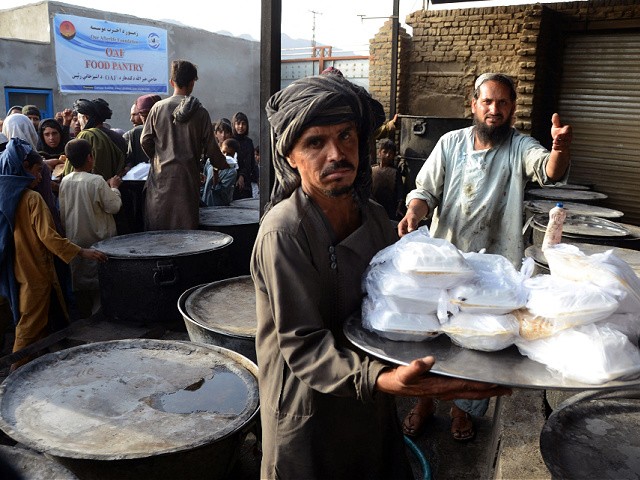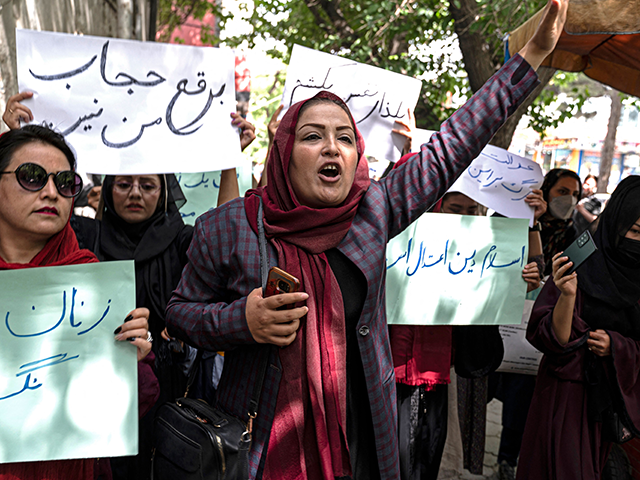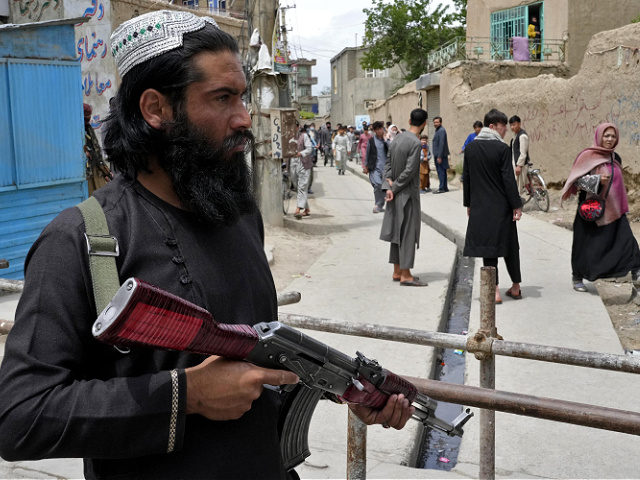The Taliban’s defense ministry on Sunday claimed the “Islamic Emirate of Afghanistan” has amassed a standing army of over 130,000 troops with hopes to bring that number up to 150,000.
Meanwhile, the Afghan economy is a wreck, poverty is rampant, and starvation is kept at bay only through massive international humanitarian efforts.

Volunteers prepare food to give a donation to the poor from the Afterlife foundation during Islam’s Holy fasting month of Ramadan in Kandahar on April 27, 2022. (Photo by JAVED TANVEER/AFP via Getty Images)
“More than 130,000 people have been registered and this process will continue. With the completion of registration, the Afghans will see an independent, well-formed and committed military who will provide security and defend the Afghan soil and borders,” Defense Ministry spokesman Inayatullah Khwarazami boasted to Afghanistan’s independent Tolo News.
Khwarazami said the female employees who worked for the elected government overthrown by the Taliban last year are still at their posts and “still receiving their salaries,” but the “Islamic Emirate and Defense Ministry will make a decision about them” soon.
Khwarazami also said the Islamic Emirate has not reached a final decision about what its military uniforms will look like.
The Taliban is still fighting against a resistance movement called the National Resistance Forces of Afghanistan (NRF), which includes many former members of the U.S.-trained Afghan military and police.
The Taliban and NRF both claimed significant military victories in the valleys south of Kabul last week. NRF commanders claim they killed at least 200 Taliban militants in recent clashes, and the Taliban committed “war crimes and crimes against humanity” in response.”
The Taliban responded by posting videos of alleged NRF fighters who were captured or switched sides to join Taliban forces. The NRF claimed these were actually hapless civilians rounded up by the Taliban to serve as props in their video.
The European Union and United Nations said the Taliban propaganda videos were “extremely worrying,” with some of them showing acts of extreme brutality toward captives, and called for “further verification” of reported atrocities from the Panjshir and Andarab valleys.
Kabul residents on Monday told the UK Guardian life in Afghanistan is considerably worse under Taliban rule, especially for women, who have been excluded from education and employment.
“Current restrictions on women’s employment have been estimated to result in an immediate economic loss of up to $1 billion – or up to 5% of Afghanistan’s GDP. There is almost universal poverty in the country,” U.N. Women Executive Director Sima Bahous reported.

Members of Afghanistan’s Powerful Women Movement, take part in a protest in Kabul on May 10, 2022. (Photo by WAKIL KOHSAR/AFP via Getty Images)
International experts who spoke to the Guardian noted that a large percentage of Afghanistan’s civil service workers, teachers, and medical staff were women before the Taliban takeover. Most of those employees appear to have been banned from their jobs or forced to work under onerous restrictions. The Taliban regime refuses to answer questions about how many women are permitted to work under their control.
While Taliban officials boast about the size of their standing army, Al Jazeera News reported at the end of March that over 23 million Afghans are facing starvation. Families headed by women who have been driven away from their jobs are forced to go for days on end without food.
“Mothers cannot pay for their antenatal and postnatal care, and as evident maternal mortality and morbidity rate is increasing tremendously, and is also affecting child mortality,” said former Afghan health minister Wahid Majrooh, who remained in the country after his government fell.
“In Afghanistan, a staggering 95 percent of the population is not eating enough food,” U.N. representative Ramiz Alakbarov warned. “It is a figure so high that it is almost inconceivable. Yet, devastatingly, it is the harsh reality.”
Humanitarian groups blame Afghanistan’s paralyzed banking system as a risk factor in starvation, saying U.S. and European sanctions against the Taliban regime are preventing outside relief groups from paying staffers or purchasing supplies inside the country. As always, this critique bypasses the question of why foreigners denounced as demons by the Taliban should be feeding its captive population while the “Islamic Emirate” is busy designing uniforms for its new army.
In his drive to secure a record $4.4 billion in funding for Afghanistan, U.N. Secretary-General Antonio Guterres cited reports in March that Afghan civilians are “selling their children and their body parts” to get money for food.
“Wealthy, powerful countries cannot ignore the consequences of their decisions on the most vulnerable. Some 95% of people do not have enough to eat, and 9 million people are at risk of famine … Without immediate action we face a starvation and malnutrition crisis in Afghanistan,” Guterres said.

COMMENTS
Please let us know if you're having issues with commenting.